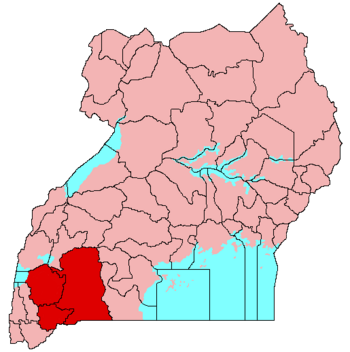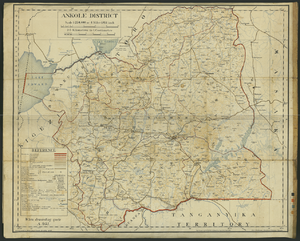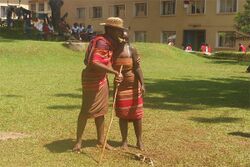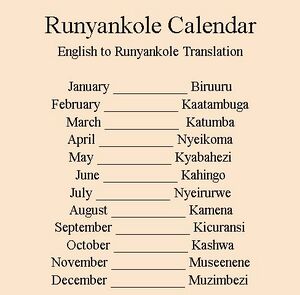أنكولى
Kingdom of Ankole Obugabe Bw'Ankole (Nyankole) | |||||||||
|---|---|---|---|---|---|---|---|---|---|
| 1478–1967 | |||||||||
النشيد: 'Ensi Nkore, Ensi Nkore' | |||||||||
 Location of Ankole (red) in Uganda (pink). | |||||||||
| المكانة | Kingdom | ||||||||
| العاصمة | Mbarara[1] 0°36′47.999″S 30°39′29.999″E / 0.61333306°S 30.65833306°E | ||||||||
| اللغات الشائعة | Runyankole, English | ||||||||
| الجماعات العرقية | Banyankole | ||||||||
| الحكومة | Constitutional monarchy | ||||||||
| Omugabe | |||||||||
• c. 1430–1446 | Ruhinda (first) | ||||||||
• 1944–1967 | Gasiyonga II (last) | ||||||||
• 2011–present | Charles Rwebishengye | ||||||||
| Enganzi | |||||||||
• ?–1967 | James Kahigiriza (last)[2] | ||||||||
• ?–present | William Katatumba (unofficial)[2] | ||||||||
| التاريخ | |||||||||
• تأسست | 1478 | ||||||||
• انحلت | 1967 | ||||||||
| Area | |||||||||
• Total | 16,104 km2 (6,218 sq mi) | ||||||||
| التعداد | |||||||||
• Estimate | 4.1 Million | ||||||||
| Currency | Uganda Shillings (UGX) | ||||||||
| Time zone | UTC+3 (EAT) | ||||||||
| Calling code | 256 | ||||||||
| |||||||||
أنكولى Ankole كانت مملكة للبانتو في أوغندا واستمرت من القرن 15 حتى 1967. كانت المملكة تقع في جنوب غرب أوغندا، شرق بحيرة إدوارد.[3][4]
التاريخ
Ankole Kingdom is located in the South-Western region of Uganda bordering Rwanda and the Democratic Republic of Congo. The kingdom was ruled by a monarch known as the Mugabe or Omugabe. The people of Ankole are called Banyankore (singular: Munyankore) in Runyankole language, a Bantu language.
تحت إمبراطورية كيتارا
Before the collapse of the Empire of Kitara, Ankole, or as it was known back then, Kaaro-Karungi ‘the good village’, was a small and remote area on the edges of the empire.[5]
التأسيس
According to legend, the first (and semi-legendary)[5] king of Ankole, Ruhinda Rwa Njunaki, was born as the illegitimate[6] son of Wamara[6][7] (or Ndahura),[8] the last emperor of the Empire of Kitara. His mother was known as Njunaki and was a servant in the king's palace. During the collapse of the empire, the throne was usurped by the Bunyoro and Wamara was forced to flee to Ntusi where he formed his new capital with a group of Bahima followers. Ruhinda was left behind and disguised as the keeper of the royal drum. After a while, Ruhinda fled the capital with some regalia and joined his father in Ntusi.[6]
Eventually, Ruhinda left with a group of followers on an expedition to Buzinza[6] and Karagwe,[5][6] where he, according to some sources, conquered pre-existing agricultural authorities, establishing the Kingdom of Karagwe.[5] While he was gone, Ntusi was raided by invaders (most likely the Bunyoro to get back the regalia), killing Wamara and most of the people living there. When Ruhinda returned, he found that only his mother and older brother were alive. He took them and escaped to what was to become Nkore.[6]
When he came to the area, he found that it was already ruled and forced the leader to flee and declared himself king, establishing the Kingdom of Karo-Karungi. The original area of the kingdom was a little larger than the modern-day Isingiro District.[5] He then built his capital at Mweruka but later moved it to Rurama where his first son would be born.[6]
Eventually, he would entrust the kingdom to his son Nkuba, leaving with a group of followers to return to Karagwe. However, other sources say this was when he actually conquered the area now known as the Kingdom of Karagwe.[6]
العلاقات العرقية قبل الاستعمار في أنكولى
The kingdom of Ankole expanded by annexing territory to the south and east.[9] In many cases, conquered herders were incorporated into the dominant Hima stratum of society, and agricultural populations were adopted as Iru or slaves and treated as legal inferiors.[9] Neither group could own cattle, and slaves could not herd cattle owned by the Hima.[9]
Ankole society evolved into a system of ranked statuses, where even among the cattle-owning elite, patron-client ties were important in maintaining social order. Men gave cattle to the king (mugabe) to demonstrate their loyalty and to mark life-cycle changes or victories in cattle raiding.[9] This loyalty was often tested by the king's demands for cattle or for military service.[9] In return for homage and military service, a man received protection from the king, both from external enemies and from factional disputes with other cattle owners.[9]
The mugabe authorized his most powerful chiefs to recruit and lead armies on his behalf, and these warrior bands were charged with protecting Ankole borders.[9] Only Hima men could serve in the army, however, and the prohibition on Iru military training almost eliminated the threat of Iru rebellion.[9] Iru legal inferiority was also symbolized in the legal prohibition against Iru owning cattle.[9] And, because marriages were legitimized through the exchange of cattle, this prohibition helped reinforce the ban on Hima-Iru intermarriage.[9] The Iru were also denied highlevel political appointments, although they were often appointed to assist local administrators in Iru villages.[9]
The Iru had a number of ways to redress grievances against Hima overlords, despite their legal inferiority.[9] Iru men could petition the king to end unfair treatment by a Hima patron.[9] Iru people could not be subjugated to Hima cattle-owners without entering into a patron-client contract.[9]
A number of social pressures worked to destroy Hima domination of Ankole.[9] Miscegenation took place despite prohibitions on intermarriage, and children of these unions (abambari) often demanded their rights as cattle owners, leading to feuding and cattle-raiding.[9] From what is present-day Rwanda groups launched repeated attacks against the Hima during the nineteenth century.[9] To counteract these pressures, several Hima warlords recruited Iru men into their armies to protect the southern borders of Ankole.[9]
Banyankore trace their ancestors back to the Bairu and the Bahima subgroup.[10]
الفترة الاستعمارية وما بعدها
On 25 October 1901, the Kingdom of Nkore was incorporated into the British Protectorate of Uganda by the signing of the Ankole agreement.[11]
The kingdom was formally abolished in 1967 by the government of President Milton Obote, and since then, the kingdom has not been restored officially.[12]
Because of the reorganisation of the country by Idi Amin, Ankole no longer exists as an administrative unit. It is divided into ten districts, namely: Bushenyi District, Buhweju District, Mitooma District, Rubirizi District, Sheema District, Ntungamo District, Mbarara District, Kiruhura District, Ibanda District, and Isingiro District.
قائمة الأُموگابى على أنكولى
Names and Dates taken from John Stewart's African States and Rulers (1989).[13]
- روهيندا (ح. 1430 - 1446)
- نكوبا (c. 1446 - 1475)
- Nyaika (c. 1475 - 1503)
- Nyabugaro Ntare I (c. 1503 - 1531)
- Rushango (c. 1531 - 1559)
- Ntare II Kagwejegyerera (c. 1559 - 1587)
- Ntare III Rugamaba (c. 1587 - 1615)
- Kasasira (c. 1615 - 1643)
- Kitera (c. 1643 - 1671) (joint ruler with Kumongye)
- Kumongye (c. 1643 - 1671) (joint ruler with Kitera)
- Mirindi (c. 1671 - 1699)
- Ntare IV Kitabanyoro (c. 1699 - 1727)
- Macwa (c. 1727 - 1755)
- Four joint rulers (c. 1755 - 1783)
- Rwabirere
- Karara I
- Karaiga
- Kahaya I
- Three joint rulers (c. 1783 - 1811)
- Nyakashaija
- Bwarenga
- Rwebishengye
- Kayunga (c. 1811 - 1839) (joint ruler with Gasiyonga I)
- Gasyonga I (c. 1811 - 1839) (joint ruler with Kayunga)
- Mutambuka (c. 1839 - 1867)
- Ntare V (c. 1867 - 1895)
- Monarchy placed under the Uganda Protectorate in 1896.[13]
- Kahaya II (1895 – 1944)
- Gasyonga II (1944 – 8 September 1967)
- Monarchy abolished in 1967.[13]
- Ntare VI/John Barigye, 1993–2011 (Titular king)
- Charles Rwebishengye, 2011–present (Titular king/crown prince)
شعب نكولى
Nkole people are a Bantu ethnic group native to Uganda. They primarily inhabit Ankole. They are closely related to other Bantu peoples of the region, namely the Nyoro, Kiga, Tooro and Hema peoples. Their population is 4,187,445 (9.8% of Uganda).People from Ankole region are referred to as “Banyankore”. The Banyankore speak Orunyankore, a Great Lakes Bantu language. There were an estimated 12.3 million native speakers in 2014.
مقاطعات نكولى (أماشازا)
Nkore Kingdom was divided into ten counties. These counties are now divided into various political constituencies. But the original ten counties of Nkore include:
تقويم نكولى
The Nkore calendar was divided into 12 months. They were named according to weather conditions and activities done in that period. They include:
- Biruuru
- Kaatambuga
- Katumba
- Nyeikoma
- Kyabahezi
- Kahingo
- Nyeirurwe
- Kamena
- Kicuransi
- Kashwa
- Museenene
- Muzimbezi
انظر أيضاً
- Ebyevugo، صيغة الشِعر الأنكولى
المراجع
- ^ Briggs, Philip; Roberts, Andrew (5 November 2016). Uganda (in الإنجليزية). Bradt Travel Guides. p. 534. ISBN 9781784770228. Retrieved 29 December 2016.
- ^ أ ب "Ankole monarchists' two decade battle for restoration of kingdom". Monitor (in الإنجليزية). 2021-02-02. Retrieved 2022-06-22.
- ^ "THE BANYANKOLE | Uganda Travel Guide" (in الإنجليزية الأمريكية). 2014-08-06. Retrieved 2024-02-06.
- ^ "Nkole". www.britannica.com (in الإنجليزية). Retrieved 2024-08-17.
- ^ أ ب ت ث ج The Early State. De Gruyter. 2011. pp. 132–134. ISBN 9783110813326.
- ^ أ ب ت ث ج ح خ د "The Legend of Ruhinda and Foundation of Ankole and Karagwe – Bunyoro-Kitara USA" (in الإنجليزية الأمريكية). Retrieved 2022-06-24.
- ^ Kasule, Joseph (2022). Historical Dictionary of Uganda (2nd ed.). Rowman & Littlefield. p. 19. ISBN 9781538141755.
- ^ Briggs, Philip; Roberts, Andrew (2010). Uganda. Bradt Travel Guides. p. 9. ISBN 9781841623092.
- ^ أ ب ت ث ج ح خ د ذ ر ز س ش ص ض ط ظ ع Byrnes, Rita M. (1992). "Banyankole". In Byrnes, Rita M. (ed.). Uganda: a country study (2nd ed.). Washington, D.C.: Federal Research Division, Library of Congress. pp. 59–60. ISBN 0-8444-0749-6. OCLC 25831693.
 هذا المقال يضم نصاً من هذا المصدر، الذي هو مشاع.
هذا المقال يضم نصاً من هذا المصدر، الذي هو مشاع.{{cite encyclopedia}}: CS1 maint: postscript (link) - ^ "Runyakore History and Culture" (PDF). Runyakore L&C. 26 January 2021.
- ^ "The Ankole Agreement 1901" (PDF). Archived from the original (PDF) on 2019-01-12. Retrieved 2014-10-12.
- ^ The Observer Media Ltd. :: The Weekly Observer :: Uganda's Top Resource site Archived 3 ديسمبر 2007 at the Wayback Machine
- ^ أ ب ت Stewart, John (1989). African States and Rulers. London: McFarland. p. 201. ISBN 0-89950-390-X.
وصلات خارجية
- World Statesmen - Uganda
- A tour guide to Ankole Culture - Uganda
- Historical map of Ankole
- The Ankole Times
قالب:Subnational monarchies of Uganda
خطأ لوا في وحدة:Authority_control على السطر 278: attempt to call field '_showMessage' (a nil value).







